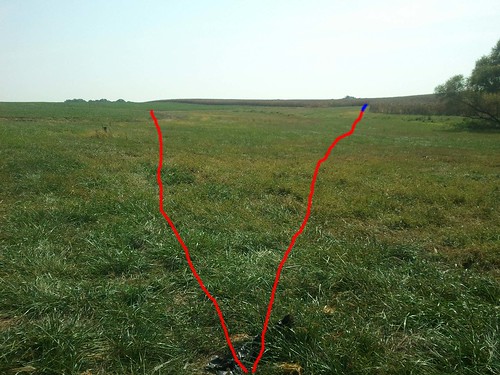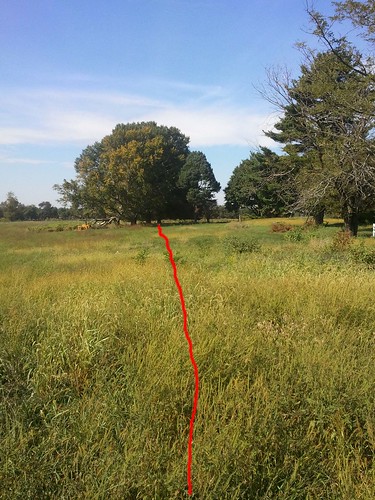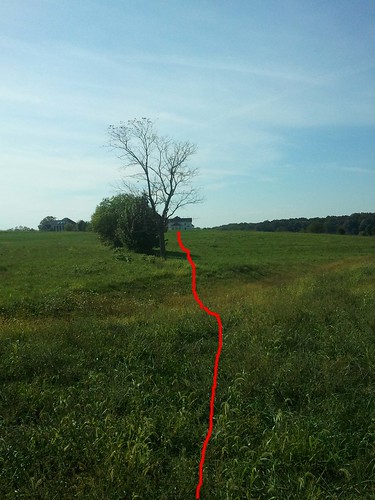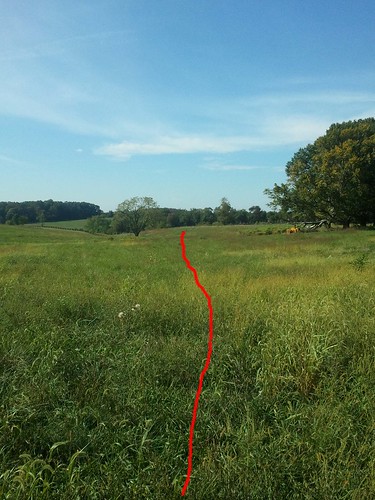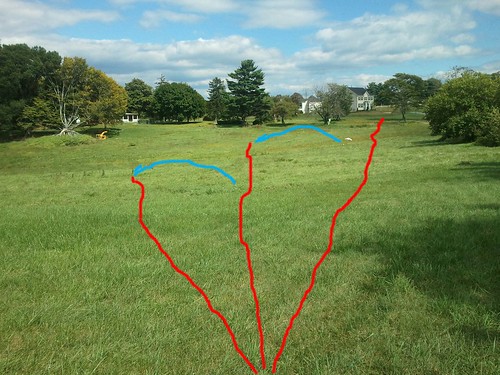Canal near Rebel Ridge Farm
This morning Laddie and I trained with Patty's group, as we do as often as possible, given my work and travel schedule. In this case, we trained with her group both yesterday (Friday) and today, in both case at a technical pond known as "Mitchell's Pond" at the canal in Elkton, MD, near Rebel Ridge Farm. This is one of Patty's favorite places to train her dogs, and we've trained with her there several other times before.
Gaby is often there with Buster, her Lab, and possibly Gus, her Chessie. When Gaby trains with Patty, Patty runs Buster, while Gaby runs Gus (if he's there) and takes turns throwing. For today's training, Gaby was there with Buster, while Gus, who is injured, was home. As usual, Patty ran Buster. Buster is entered in his third Qualifying Stake next weekend, and Patty will run him there again.
Today's temps were in the 70s, with a few clouds and a good wind. The direction of the wind was variable and unpredictable.
For today's session, Patty had one of the other trainers, a guy named John, set up a water triple, and then later Patty set up a water blind. They may have run some other retrieves earlier. I was sick yesterday and slept in till 6:30 AM this morning. With the two hour drive, that made Laddie and me an hour late to the training.
John is an AKC Field Trial judge, and is notorious for his competition set-ups. I've heard that at one trial he judged, only four dogs made it thru the first series. He usually sets up something difficult for us at Patty's practices, also, when he's given the opportunity.
I don't know if today was one of his most difficult set-ups, but I decided that the individual retrieves were challenging enough that I wouldn't add to the challenge for Laddie by running any multiples. By contrast, Patty ran her Q dogs (those that she is currently running in Qualifying Stakes) on the set-up as a delayed triple, and even a couple of her younger dogs ran the outer retrieves as a double before running the long center gun as a single. She did run her younger dogs on singles, as I did with Laddie.
Here's a description of today's set-ups:
SERIES A. As run by Laddie, three singles
As run by Laddie (Patty used a different sequence), the first mark was on the right, a WB thrown left to right on an angle back at 200 yards. The line to the first single was a channel swim with points on both sides. The second mark was on the left, a WB thrown left to right to the end of a point at 170 yards. The second single was a LWLWL, with the bumper thrown into cover. The third mark was in the center, a duck thrown right to left at 210 yards into a mowed area surrounded by high cover. The line to the third mark was a channel swim, then crossing an island and back into water, then thru a stand of high cover known as "frag", to the bird.
Laddie ran all of the marks in Series A fairly well, though not as well as some of the other dogs and not well enough for a high score in a Q. For the first mark on the right, I needed to handle him to keep him off one point on the right, though he held his line without help the rest of the time. For the second mark, he ran an excellent line but, seeing that water still lay before him as arrived in the area of the fall, and not picking up the scent of the bumper, he leapt in the water and continued on his line. Patty, who was throwing, called hey-hey, and Laddie then came back, picked up the bumper, and brought it in. Laddie ran the third mark in the center without help.
Although Laddie didn't have the terrible problems with returns that he sometimes does, he did run the bank on some of his returns in situations where the other dogs took the same route back that they had taken out. I would have preferred that he not cheat, since it's a lost opportunity to practice a good line, but since I've heard that such returns would probably not be penalized in competition, in this case I preferred not to make an issue of Laddie's returns. I feel that doing so might create an impediment in his motivation to return at all, and since that's Laddie's greatest weakness, I feel that requiring him to take a straight line back on his returns is a low priority. I recognize that the more he does it, the harder it might be to prevent it in the future, but nonetheless it still seems a lower priority than strengthening his motivation on the returns.
Running singles for confidence
My primary goal in today's work was to improve Laddie's confidence, since he has been popping and showing other signs of confusion or stress when we've trained with Patty. I've tried other strategies in previous sessions which have not stopped such behaviors, but today I seem to have hit upon a strategy that was effective: running the marks as singles. Laddie neither popped nor even peeked on any of the marks, and came closer to showing off his skill as a marker than he has in most of our previous sessions with Patty.
So I think I can now say that for Laddie, a good approach to having him practice without popping when training with a Field Trial group such as Patty's, might be to have him run singles rather than multiples, at least on tight set-ups. Hopefully after more weeks of training on singles, his confidence will have built up enough that we can again begin running him on multiples.
SERIES B. Keyhole water blind
Patty set up a 160-yard water blind for the advanced dogs. The line started with a channel swim between two points. Then came the primary challenge of the blind, a 3-foot wide keyhole passage with an old sign on a metal pole on the left, and a point of land on the right. Once thru that passage, the line was across another inlet of water, thru a stand of high cover at water's edge, and to the blind behind the high cover.
Laddie handled reasonably well until I got him thru the keyhole. Then he ran up onto the point of land and turning toward the SL, crouched to eliminate. As soon as he finished and began to kick dirt back with his front paws, I whistled, hoping to cast him back into the channel where I could keep him in sight, but he turned, leapt into the channel behind the point and out of sight, and then completed his run to the blind on a straight line but out of my control. Patty later told me that from a judging point of view, it wouldn't have mattered that he went OOC, since he would have been disqualified earlier for eliminating during the outrun. A dog might not be penalized for eliminating on the way back with a bird, but is disqualified if the dog eliminates on the way out.
Practicing with Singles versus Multiples
In today's practice, I ran Laddie on John's set-up as three singles, as did Patty with some of her young dogs. For her more advanced dogs, Patty ran the set-up as a double and a single, or as a delayed triple.
I might mention that running a dog on singles in a multiple-gun set-up is not a strategy limited to young dogs. I know of several trainers who believe that once a dog "understands" what a multiple is, the dog should be run primarily on singles in multiple-gun set-ups.
However, Patty does not follow that practice, and I'm under the impression that Alice does not, either.
I think the primary advantage of running singles is that it strengthens the dog's marking, which will be the primary consideration in scoring.
On the other hand, even if the dog has a good memory, there's more of a challenge to running multiples than simple memory. For example, when multiple marks are down, they can act as diversions for one another, which can be especially challenging if the go-bird is longer than one of more of the memory-birds, or if a flyer is used as a memory-bird while the g0-bird is a dead bird. As another example, the dog may see one picture when a multiple is thrown, but then if one or more guns retire, the dog sees an entirely different picture when she's lining up to run the memory-birds after she's returned with the go-bird.
I suppose that here, as in other areas of dog training, maintaining a balance is best. I guess my goal with Laddie will be plenty of singles, balanced by plenty of multiples.
